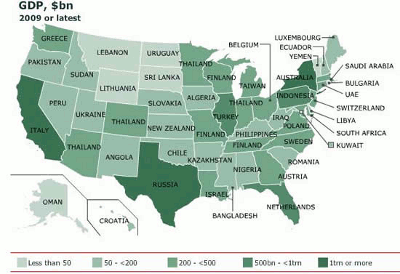While emerging-market nations seem to be juggernauts on the brink of imminent victory over the established US and European economies, it pays to look at a bigger picture, observes Nicholas Vardy of The Global Guru.
In the aftermath of the housing collapse and the "Great Recession," the slow-motion implosion of the US economy is taken as gospel.
Conventional wisdom has it that thanks to the combination of exploding government debt and Wall Street cronyism, the United States is on track to become "the next Argentina"—a formerly prosperous nation that self-destructed, descending into political corruption and economic chaos.
As radio personality Paul Harvey was fond of noting: "At times like these, we need to remember that there have always been times like these." In the 1970s, Americans grew up with two myths:
- the Soviet Union would dominate the United States militarily
- the Japanese would dominate the US economically
With the Soviet Union erased from the map, and the Japanese stock market below the levels it traded at in 1984, both fears seem almost quaint.
Yet we take it as gospel today that China is destined to dominate the United States economically in the 21st century. Perhaps. But perhaps not.
I believe that much of China's economic growth is based on a misallocation of resources on a scale never seen in history. A good example is White Elephant projects like building a copy of Manhattan and Disney World in the middle of nowhere.
Throw in the oppression of Chinese citizens' human rights, and China looks a lot more like the next Soviet Union than it does like the next United States.
It's also worth reminding ourselves where the world's new economic challengers stand in comparison to the United States today. Despite the high economic growth rates of developing nations, the United States is by far the world's wealthiest nation as measured by Gross Domestic Product (GDP)—the broadest measure of economic wealth.
And the rest of the world isn't even close. In 2010, US GDP was $14.6 trillion. That means that the US economy is as large as the next three-largest economies in the world—China, Japan, and Germany—combined.
The map below—originally published in Britain's Economist magazine—puts the size of the United States' global rivals in perspective. On the map, the name of each US state is replaced by a country, whose GDP equals approximately that particular US state's GSP (gross state product). A quick glance at the map leads to some fascinating—and unexpected—comparisons.
Standing alone as a country, California would be the eighth-largest economy in the world, and approximately the size of Italy. New York State is the equivalent of Australia.
For all the press it garners, Greece is just about the size of Washington State. Sweden is just another North Carolina with lousier weather. Despite years of auto-industry hardship, the economy of Michigan is still the same size as Taiwan's.
The countries of the Middle East fare particularly badly. Iraq is the size of West Virginia. Libya is the size of Delaware. Israel's economy is equivalent to that of Louisiana.
That all said, this map looked very different five years ago—and will look even more different five years from now. The BRICs (Brazil, Russia, India, and China) have risen remarkably fast. Five years ago, China's economy was the size of Texas' and California's combined. Today, it is about twice the size of those two US states combined.
California's economy alone is still larger than that of India—but not for long. Brazil's economy just passed the Golden State last year. Texas' economy is half the size of California's, but its GSP compares to that of Russia.
The US Economic Map: Two Caveats
Not surprisingly, reactions to the map have been mixed. The first criticism is that the map is based on nominal GDP—how much wealth is generated in dollar terms—and not how many goods and services those dollars buy.
Economists sometimes use purchasing power parity (PPP) when comparing the size of global economies. Because prices for goods tend to be lower in developing countries, this measure makes poorer countries appear wealthier than they really are.
But in taking a birds-eye view of wealth generation in the global economy, that approach makes little sense. Think of PPP as similar to a "cost of living adjustment" on a country level. Within the United States, $50,000 in Kansas buys you a lot more than it does in Manhattan. But as a measure of wealth in absolute terms, having $50,000 in your bank account is the same no matter where you live, in Kansas or Calcutta.
Second, the map does not adjust for population. Let's say China does become the largest economy in the world in 20 years' time. Yet, because of its large population, even if it continues growing at its current pace (a huge assumption), by 2050, it will only be as wealthy as former Communist Hungary is today. That puts the United States and the rest of the developed world ahead for a long, long time.
In 1790, the United States was a new, tiny nation of 4 million, about the size of Ireland today. Europe's population was 180 million, while India's was 190 million, and China's was 320 million. Only seven cities had a population of 5,000 or more; just 12 had a population above 2,500. The United States had an agricultural economy with practically no factories.
By 1885, the United States was No. 1 in the world in manufacturing. It produced almost 30% of the world's manufactured goods, to outpace both the British Empire and the spanking new Germany.
Sure, there is a chance that China could replicate the success of the United States. But even the United States had to endure several economic depressions, as well as a Civil War during its remarkable rise. To think that China—or any other economic rival superpower—will avoid similar challenges ignores the lessons of history.
Underestimating the US economy has become the new global financial sport. But in the 21st century, the cutting-edge global industries—whether Silicon Valley, Hollywood, or Wall Street—all are products of the US economic experiment.
The US economic map versus the world provides a vivid reminder of just where the United States stands.
Subscribe to The Global Guru here...
Related Reading:
What to Buy (and Sell) in 2012
2 Solid Plays on India's Growth
How Is Europe's Quasi-QE Working?






















